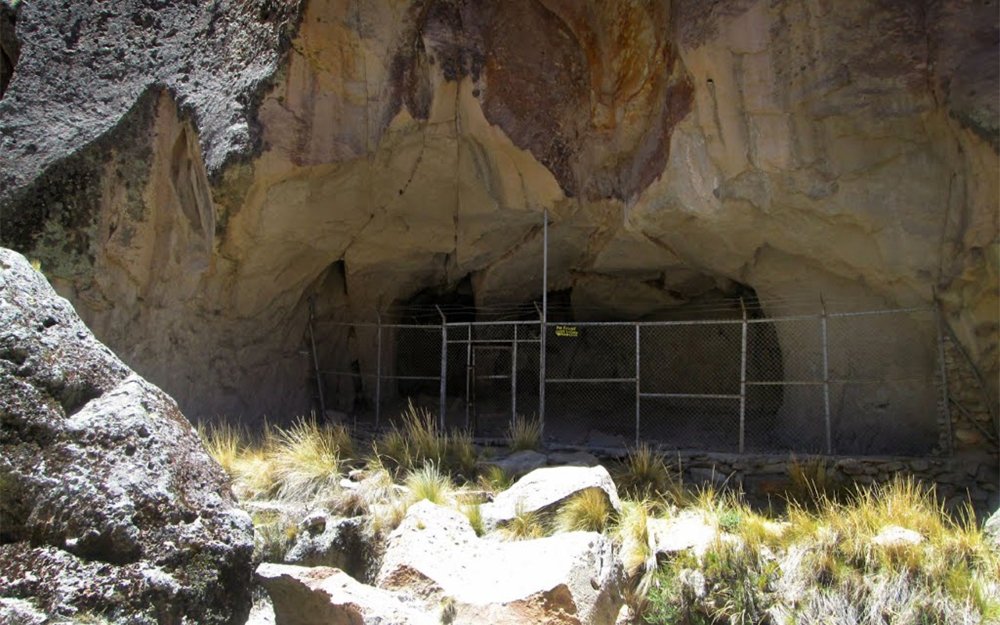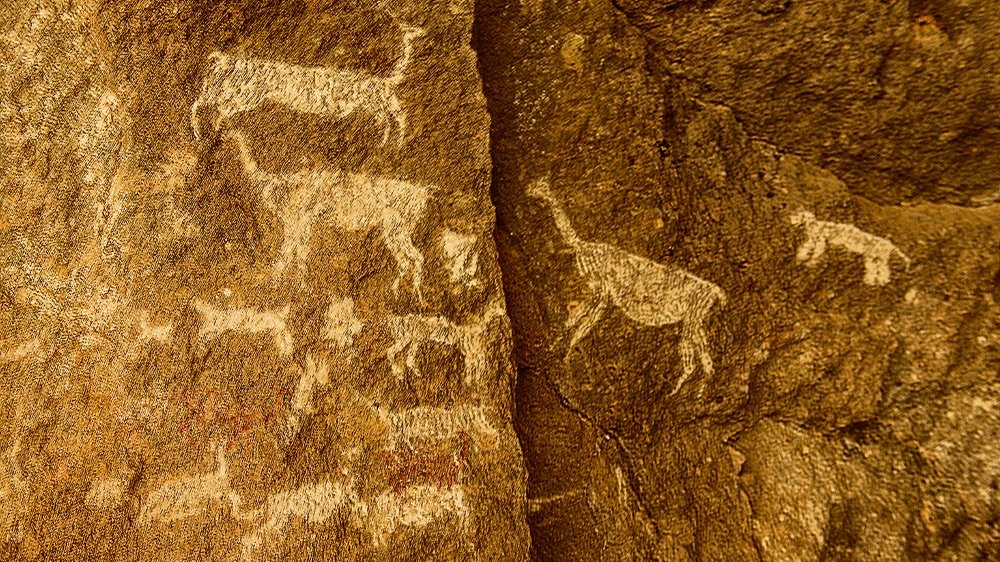Sumbay Cave | Arequipa
The Sumbay Cave is a tourist attraction located in the region of Arequipa, Peru. It is located in the district of Andaray, in the province of Caylloma. This cave is known for its cave paintings, which date back thousands of years and are an important archaeological heritage of the area.
The cave paintings in Sumbay Cave depict human figures, animals, and geometric shapes, offering a fascinating window into the life and beliefs of the pre-Columbian cultures that inhabited the region. The cave and its paintings are a popular destination for tourists interested in Peru’s history and archeology, as well as for those who enjoy hiking and exploring nature.
As for the specific meaning of “Sumbay” in Quechua, it may depend on the etymology and cultural context of the region. Place names in Quechua often have meanings related to geographic features, local legends, or aspects important to the community that inhabits them. However, without more context or specific information about the origin of the name “Sumbay”, it is difficult to determine its exact meaning in Quechua.
As for the specific meaning of “Sumbay” in Quechua, it may depend on the etymology and cultural context of the region. Place names in Quechua often have meanings related to geographic features, local legends, or aspects important to the community that inhabits them. However, without more context or specific information about the origin of the name “Sumbay”, it is difficult to determine its exact meaning in Quechua.
History of the Cave of Sumbay | Arequipa
The history of Sumbay Cave dates back thousands of years, when it was inhabited by pre-Columbian populations in the Arequipa region of Peru. These populations left a legacy in the form of cave paintings that can still be admired on the cave walls.
The cave paintings of the Sumbay Cave are considered to be part of the oldest rock art in South America, and are estimated to be at least 6,000 years old. These paintings are an invaluable testimony of the life, beliefs and practices of the cultures that populated the region in prehistoric times.
The motifs represented in the paintings include human figures, animals such as camelids (llamas and alpacas), birds, as well as geometric and abstract forms. These designs provide information about the cosmovision, hunting, agriculture and other aspects of the life of the ancient communities that occupied the area.
Sumbay Cave was discovered by Spanish colonizers in the 16th century, but its cave paintings did not receive significant attention until more recent times, when they were studied and valued as part of Peru’s archaeological heritage. Today, the cave is an important tourist destination in the Arequipa region, attracting visitors interested in the history, archeology and culture of pre-Columbian civilizations.

What to see in Sumbay Cave?
In Sumbay Cave, in addition to its impressive natural environment, visitors can enjoy the following attractions:
- Cave Paintings: The main attraction of the cave are the cave paintings that adorn its walls. These paintings, dating back thousands of years, depict human figures, animals and abstract symbols. Observing and learning about these ancient works of art provides a fascinating insight into the life and beliefs of the pre-Columbian cultures that inhabited the region.
- Hiking and Exploration: The cave is located in a stunning natural setting, making it an ideal place for hiking and exploration. Visitors can enjoy hiking around the cave, explore other rock formations and enjoy panoramic views of the surrounding landscape.
- Flora and Fauna Observation: The area surrounding the cave is home to a variety of flora and fauna species. Visitors may have the opportunity to observe birds, small mammals and other wildlife while exploring the cave’s surroundings.
In short, Sumbay Cave offers a unique experience that combines history, archaeology, nature and adventure. It is a fascinating destination for those interested in exploring Peru’s ancient past and enjoying the natural beauty of the Arequipa region.
Cave paintings in the Sumbay Cave
The cave paintings at Sumbay Cave are an archaeological treasure that offer a fascinating window into the region’s prehistoric past. Dating back thousands of years, these paintings depict a variety of human figures, animals and abstract symbols, offering intriguing insight into the life and beliefs of the cultures that inhabited the area in ancient times.
Some of the highlights of the cave paintings at Sumbay Cave include:
- Human Figures
Representations of human figures can be found in various activities, such as hunting, dancing or possibly in ceremonial rituals. These figures provide information about the clothing, ornaments and daily activities of the people who inhabited the region at that time.
-
Animals
The paintings also include representations of animals, especially camelids such as llamas and alpacas, which were vital for the subsistence of ancient Andean cultures. These animals were used for food, wool and transportation, and their presence in the paintings reflects the importance they had in the lives of the people who lived in the area.
- Abstract Symbols
In addition to human and animal figures, the cave paintings at Sumbay Cave also include a variety of abstract and geometric symbols whose meaning may be more difficult to interpret. These symbols could have religious, astronomical or simply decorative connotations.
- Coloration and Technique
The cave paintings at Sumbay Cave show a variety of colors, ranging from dark to lighter tones. It is believed that these colors were created from natural pigments such as iron oxides, clays and charcoal. The technique used to create the paintings ranged from the use of fingers to improvised brushes made from plant fibers.
Taken together, the cave paintings at Sumbay Cave offer a unique and evocative look into the region’s ancestral past, and are a testament to the artistic ingenuity and deep connection to nature of the ancient cultures that created them.

How to get to Sumbay Cave?
To get to Sumbay Cave from Arequipa, generally follow these steps:
- Transportation from Arequipa: You can take a bus or hire a tour from Arequipa to the Caylloma region, where Sumbay Cave is located. Tours usually include transportation and specialized guides.
- Road Trip: Most trips to the Caylloma region from Arequipa involve a road trip. The distance may vary depending on the route taken, but generally it is approximately 3 to 4 hours by car.
- Route to Andaray: Sumbay Cave is located in the district of Andaray, in the province of Caylloma. Once in the Caylloma region, you will continue to Andaray. This is a small village near the cave and is often used as a starting point to reach it.
- Cave Access: Once in Andaray, there are roads and trails leading to Sumbay Cave. Depending on local conditions and regulations, you may need a local guide to access the cave, as the area can be remote and require specialized knowledge.
- Hiking or Hiking: To reach the cave itself, you may need to walk or hike a short distance from the nearest accessible point by vehicle. Be sure to wear appropriate walking shoes and be prepared for the terrain conditions.
It is important to keep in mind that access conditions and regulations may vary, so it is advisable to obtain updated information before planning your visit. In addition, hiring a local guide can enhance your experience and ensure that you get the most out of your visit to Sumbay Cave.
Recommendations to visit Sumbay Cave
Here are some recommendations for visiting Sumbay Cave and having a memorable experience:
- Plan Ahead
Research access schedules, local regulations and any special requirements for visiting the cave. Make sure you have all the necessary information before embarking on your trip.
- Visit with a Guide
Consider hiring the services of a local guide or tour operator who specializes in the area. A guide can provide detailed information about the history, archeology and culture of the cave, enriching your experience.
- Clothing and Equipment
Wear comfortable clothing suitable for walking and sturdy footwear. The cave can be rocky and the terrain can be uneven, so make sure you are prepared for walking. It is also advisable to bring sun protection, insect repellent and drinking water.
-
Respect for the Environment
Remember that you are visiting an important archaeological site and a protected natural area. Respect the signs, do not leave trash and avoid damaging the cave paintings or other elements of the environment.
- Responsible Photography
If you plan to take pictures inside the cave, be sure to do so responsibly. Avoid using flash if possible, as the intense light can damage the cave paintings. Respect local restrictions or regulations on photography at the site.
- Enjoy the Natural Environment
In addition to the cave paintings, Sumbay Cave is located in a stunning natural environment. Take the time to enjoy the scenery, observe the local flora and fauna, and connect with the nature surrounding the cave.
- Learn and Ask
Take the opportunity to learn about the history and culture of the region. If you have questions, feel free to ask your guide or local experts. The cave has a rich history that can enrich your understanding of the region’s past.
By following these recommendations, you will be able to enjoy your visit to Sumbay Cave to the fullest and appreciate the beauty and historical importance of this unique archaeological site in the Arequipa region of Peru.












